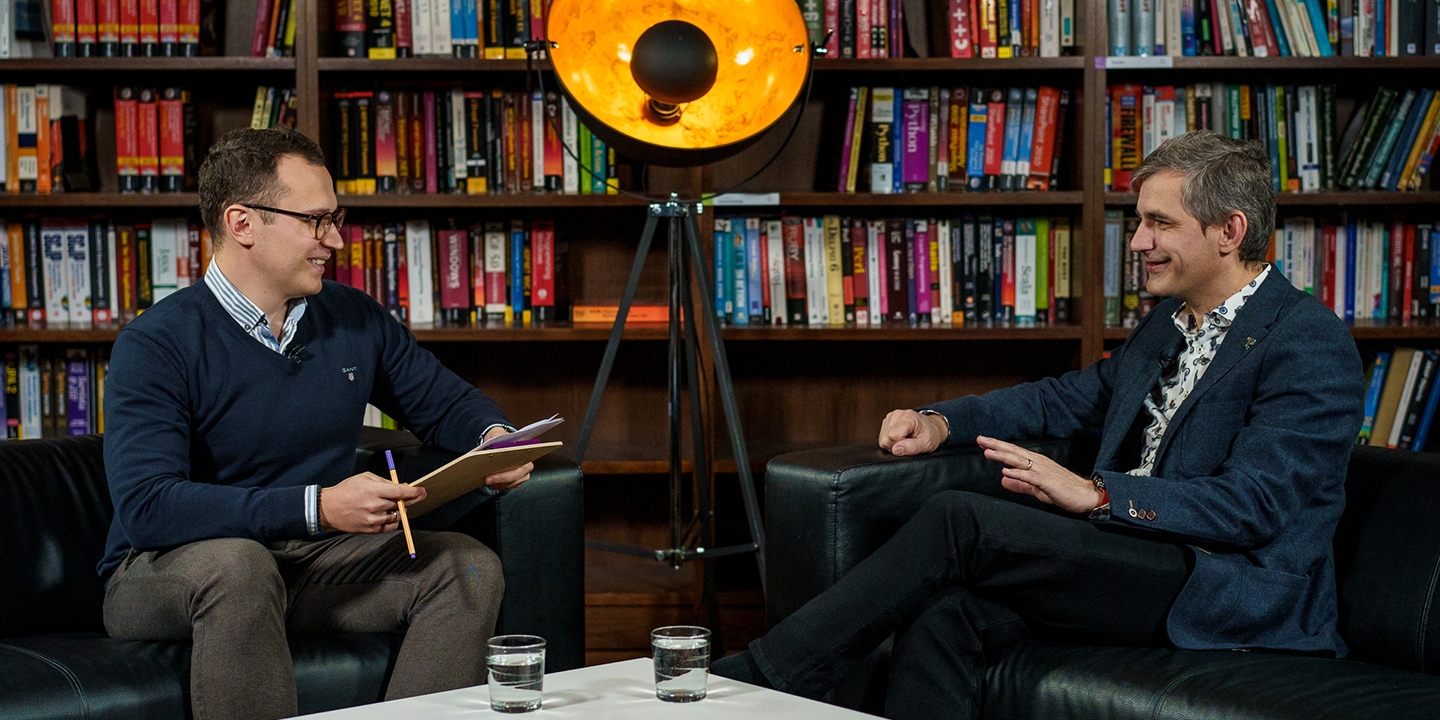- Insights hub
- /
- Business at the speed of ...

Business at the speed of light with Stephen Watson
- DetailsAbout the talks
- TranscriptTranscript
- Resources1 File
Business at the speed of light with Stephen Watson
Michał Grela
Relationship Manager at Future Processing
In this episode Michał asks Steve Watson a few questions and dig deeper into the topic of how technology can be leveraged to reduce businesses operating costs, increase revenues, and/or improve our businesses ability to innovate.
Michał Grela (MG): Hello, and welcome to another episode of IT Leadership Insights by Future Processing. Today, my guest is Steve Watson, and we’ll be talking about Business at the Speed of Light, leveraging technology to support business goals. It’s been, well, 200 years since humanity started using steam locomotives to transport coal, which definitely was a revolution and a disruption itself that changed the course of history.
But if we fast-forward to today, a fiber optic cable is the infrastructure transporting information at the speed of light, fueling another revolution which transcends the domains of business and impacts every facet of how we work, live, play, and learn. But suddenly, we’ve all been reminded of something that perhaps we had taken for granted. With many more of us homeworking, homeschooling and home playing due to a current pandemic, we are reliant on technology more than ever. On the one hand, we are taking the technology for granted, but on the other, do we fully leverage its capabilities?
So my guest today, Steve Watson, he recently wrote a great piece I came across on how adopting high speed fiber broadband allows a business to focus on the benefits, realization, opportunities, this technology transformation presents. I really liked this article and I really wanted to have this conversation with Steven over it. So today, I’ll be really honored to ask Steve a few questions and dig deeper into the topic of how tech can leverage through this business operating costs, increase revenues and/or improve businesses’ ability to innovate. So hi, Steve. It’s a great pleasure to have you here today.
Steve Watson: Hi, Michal. Good afternoon. Thank you for the opportunity to speak this afternoon.
MG: Could you introduce yourself to our listeners, please?
SW: Yes, of course, Michal. Thank you. My names is Steve Watson. I work for a company called Peru Consulting. My background is in program management and commercial management and I’ve been in that field for almost 30 years now. I’ve been at Peru Consulting for just short of six years. Peru is a UK-based IT consultancy company with clients throughout Europe and, indeed, worldwide. We specialize in three areas: strategy and architecture, transformation and optimization, and the area for which I’m practice lead, sourcing and commercial management.
MG: Brilliant. Thanks, Steve. So let’s jump right on it. I’m just curious to ask, why did you decide to write this article in the first place? I mean, why did you think it’s still important and still relevant in the year 2020?
SW: Thank you, Michal. I originally wrote the article back in 2014 and at the time I was still working at BT, British Telecommunications. I was the program director for the super fast broadband rollout in the North East of England. My role involved then speaking to lots of business owners, and whilst they would always have lots of questions about when super fast broadband was going to become available for them and, quite often, they were quite frustrated that they couldn’t get access to it quickly enough, very few business leaders had really thought about how it could benefit their business when it did become available. So if I now fast-forward to six years later to 2020 and the pandemic, as you’ve mentioned, has resulted in huge numbers of people switching to homeworking where now the daily commute is from their bedroom to their study.
MG: Tell me about it.
SW: Indeed, likewise. All of a sudden, people are realizing the impact of poor or unreliable broadband and, in fact, I did last week because mine went down for two days. It’s quite common these days to have 10, 15, 20 devices online in a single household. When you think about it, multiple mobile phones, multiple smart TVs, wireless printers, laptops, iPads, all those other devices, intelligent devices, you’ve got things like your Alexa and all those sort of devices. But if you think about it for businesses, there’s a huge question about whether a full return to the office will now ever be commercially viable. So digital transformation and reliable broadband is going to become even more crucial to interconnect with their remote workers.
MG: Yeah, definitely. But my thought is that, frankly speaking, ultimately it is the impact on the bottom line that businesses are looking for. So what are the cashable benefits businesses can realize by grasping the business change and transformation opportunities available?
SW: Yeah, absolutely, Michal. Firstly, just to say, although the obvious answer would be to say increased business productivity driven by digital transformation in turn leads to cost optimization, and that is very true. But to be honest, the killer app, I believe, for businesses is when they see the opportunities to innovate and disrupt in the marketplace. Sometimes though, you have to look forward. In order to look forward, you need to look back.
So let me give you a couple of examples. Six years ago, when this article was originally written, Amazon were already on the ascendancy and bricks and mortar bookstores were in decline. Now if you look at Amazon, they threaten to disrupt just about every consumer marketplace out there. It could be food, music, electronics, you name it. Whatever happened to Borders Books? They are history, basically. And most of the product-based high street retailers are disappearing fast. Just look at town centers these days. Lots of shops closing down, stopping trading. So if you’re in that sort of business, if you’re in retail, how do you disrupt? Well, for example, if you can offer a seamless experience online and in store, that would certainly help. So, think about the ability to make a video call with a shop assistant, who is on-premise, about the product you’re interested in, but being able to do that at a click, from your desktop.
I’ll take a different example. Again, whatever happened to Kodak? Kodak were an iconic world leading brand in both mass market photography and also high quality specialist photography. Well, what happened to Kodak is the iPhone. With increased better quality camera resolution, the iPhone camera has approved year on year, whereas Kodak hesitated over responding to this disruption. They really delayed and delayed their entry to the digital photography marketplace. The result was ultimately, Kodak filed for bankruptcy in 2011. And although they were actually, eventually rescued, their business focuses now around print and software solutions, and movies as well, motion pictures. They don’t really focus so much on cameras these days.
MG: Yeah, definitely. So in one of the pieces of the article you wrote, you mentioned this famous Gartner comment that every industry will be digitally remastered. It is not optional. It will happen to you whether you like it or not, et cetera, et cetera. So you cannot escape. It’s not something you have a choice about. And business leaders need to start drawing up exploitation plans at the speed of light to ensure their survival. That was more or less the point. I’m sure that we’ve all and all of our listeners agree to that, but, at the end of the day, do business really do that today? And if not, then why? Because looking at statistics, we have to bear in mind that only one in six SMEs in Europe is highly digitized.
SW: Yeah. Well, here’s a funny thing, Michal, when I actually redrafted the article a couple of months ago, most of the facts and figures that I pointed to in the original article, I updated, because they were out-of-date. But that actual Gartner Conference quotation was from six years ago, not last month or a couple of months ago. So it’s a really good question, but let’s turn it around for a second. And matter of fact, if only one in six SMEs are highly digitized, then there is still an opportunity for those more farsighted SMEs to jump ahead of the competition and disrupt the market place. The time may well be now.
Now, why do we have many more SMEs who are not yet digitized? Well, in fairness, the management team of SMEs have 1,001 business priorities across their desks every week. I should know, because I work for an SME. Digital transformation is just one of those priorities. Many business owners feel unprepared and, frankly, not well supported in taking the gamble of investing their hard earned cash on digital transformation. They also just don’t have the budgets to hire a Magic Circle consultancy or an IT partner to help them. But that’s where IT partners such as Future Processing and Peru Consulting come in. We have literally hundreds of years of deep and broad IT experience at our fingertips. We don’t cost a fortune, and quite often we are able to work with businesses on a risk/reward basis, which means if the business doesn’t achieve its outcomes, it doesn’t achieve its desired goals, we don’t get paid.
MG: Yeah, definitely, that’s a really good point. But bearing in mind current situations where if you look at the landscape now, plenty, if not most, but a lot of organizations and businesses are struggling to survive. So in your opinion, what is the space for change and disruptions? Is there any? Because, at the end of the day, my understanding is that now it’s all about business as usual instead of world changing.
SW: I think it’s a really good point. I think it’s probably the question of the generation. All businesses are on a journey just now. The first stage of this, as you say, is survival, and that involves tactical changes to keep cash in the business, support homeworking, shore up revenue, secure revenues, and if possible, secure pipeline. But if the tales of Kodak and Borders Books tell us anything, it is that eventually businesses will need to move from survival to adaptation and will need to move from adaptation to innovation. Now, here’s the really difficult balancing act. If businesses move too quickly, then they risk making huge mistakes and going down the wrong roads, and they may only get one chance at this. However, if businesses move too late, businesses will be left behind, just like Kodak and Borders Books were, and arguably, also a lot of high street retailers.
The reality is the right time to move from survival to adaptation and from adaptation to innovation will differ for the different business sectors. It is arguably the most important decision business leaders will ever make in their careers. Peru stands ready to help those business leaders make the right decisions at the right time, and I know Future Processing will stand ready to help business leaders on their digital transformation journey.
MG: Yeah. Let’s hope we’ll be able to so when the time is right. Thanks, Steve, for sharing your thoughts. It was really a pleasure to have this conversation with you. Congrats on writing this super interesting piece and I’ll be definitely watching your space on LinkedIn to see what else will you produce in the future. And thank you, our listeners, for listening to yet another episode of IT Insights by Future Processing. If you liked it, if you found it useful, please don’t hesitate to share it on social media and please do drop us a line if you’d like to have another topic covered in one of another episodes of IT Insights by Future Processing. Thanks. Thanks, Steve
SW: Thank you, Michal. It was a pleasure.
INSIGHTS
Check similar insights
Contact
Get in touch
Have any question about specific material?
Let us know!








